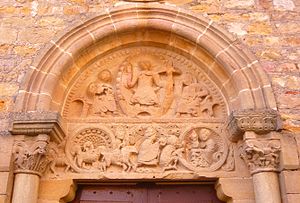Fleury-la-Montagne
| Fleury-la-Montagne | ||
|---|---|---|
|
|
||
| region | Bourgogne-Franche-Comté | |
| Department | Saône-et-Loire | |
| Arrondissement | Charolles | |
| Canton | Chauffailles | |
| Community association | Canton de Semur-en-Brionnais | |
| Coordinates | 46 ° 12 ' N , 4 ° 7' E | |
| height | 304-445 m | |
| surface | 8.75 km 2 | |
| Residents | 691 (January 1, 2017) | |
| Population density | 79 inhabitants / km 2 | |
| Post Code | 71340 | |
| INSEE code | 71200 | |
 Fleury-la-Montagne-Tympanum of the Church |
||
Fleury-la-Montagne is a French commune with 691 inhabitants (at January 1, 2017) in the department of Saone-et-Loire in the region of Bourgogne Franche-Comté .
location
Fleury-la-Montagne is about a kilometer east of the Loire at an altitude of about 400 meters above sea level. d. M. in the old cultural landscape of the Brionnais in the south of Burgundy. The place is about 43 kilometers (driving distance) southwest of Charolles and about 72 kilometers west of Mâcon . The places worth seeing Saint-Julien-de-Jonzy and Charlieu are only eight kilometers northeast and southwest respectively. The place Marcigny is located about 13 kilometers northwest.
Population development
| year | 1962 | 1968 | 1975 | 1982 | 1990 | 1999 | 2006 |
| Residents | 394 | 415 | 430 | 526 | 587 | 561 | 608 |
In the 19th century the place had over 800 inhabitants at times, so that the parish church had to be enlarged.
economy
The hilly area around Fleury-la-Montagne has always been largely agricultural, with viticulture playing a major role until the 19th century, but was largely abandoned after the phylloxera crisis. Today cattle breeding ( Charolais cattle) is far more important. The place itself functioned as a handicraft, trade and service center for several hamlets and individual farms in the area until the early 20th century.
history
In the area of the place Fleury-sur-Loire (that was the old name of the place) there was once an estate ( villa rustica ) from Gallo-Roman times. In 1119 the then landlord ( seigneur ) transferred the place and the church to the Abbey of Cluny .
Attractions

- Only the apse , the crossing tower and the Romanesque portal of the parish church ( Église Saint-Barthélemy ) date from the 12th century; the three-aisled nave of the originally single-nave church, of which two heavily damaged capitals still exist, was built in neo-Romanesque forms in the 19th century . The tympanum of the portal, which was badly damaged during the French Revolution, shows Christ in a mandorla ; to his sides are a standing and a seated person whose identity is not clear. In the architrave below there is a depiction of an Adoration of the Kings . The two outer round fields are decorated on the inside with an unusual, circular, block pattern . The portal of the church has been listed as a monument historique since 1926 .
- The two damaged Romanesque capitals are kept in the rectory. They are also listed.
- The wooden pulpit ( Chaire á prêcher ) of the church from the beginning of the 19th century has also been classified as worthy of protection.
- A small chapel ( Chapelle de la Barnaudière ) is on the outskirts. The tower, made of hewn but not smoothed natural stone, is well worth seeing.
Web links
- Fleury - photos + information (French)
- Fleury, church and chapel - photos + information (French)
- Fleury, church - photos + information (French)
Individual evidence
- ↑ Église Saint-Barthélemy, Fleury-la-Montagne in the Base Mérimée of the French Ministry of Culture (French)
- ↑ Chapiteaux, Fleury-la-Montagne in the Base Palissy of the French Ministry of Culture (French)
- ↑ Chaire à prêcher, Fleury-la-Montagne in the Base Palissy of the French Ministry of Culture (French)
